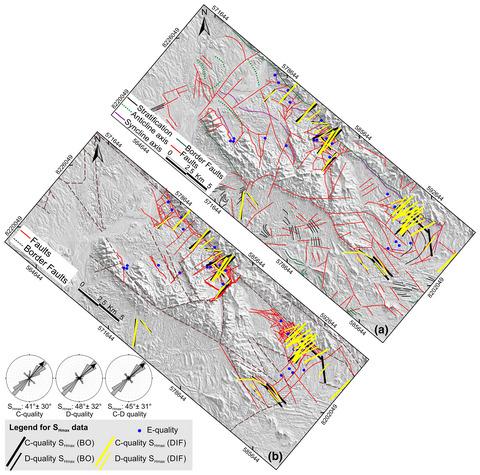当前位置:
X-MOL 学术
›
Basin Res.
›
论文详情
Our official English website, www.x-mol.net, welcomes your
feedback! (Note: you will need to create a separate account there.)
Characterising the contemporary stress orientations near an active continental rifting zone: A case study from the Moatize Basin, central Mozambique
Basin Research ( IF 2.8 ) Pub Date : 2022-02-12 , DOI: 10.1111/bre.12660 Mojtaba Rajabi 1 , Joan Esterle 1 , Oliver Heidbach 2 , Daniel Travassos 3 , Silvestre Fumo 3
Basin Research ( IF 2.8 ) Pub Date : 2022-02-12 , DOI: 10.1111/bre.12660 Mojtaba Rajabi 1 , Joan Esterle 1 , Oliver Heidbach 2 , Daniel Travassos 3 , Silvestre Fumo 3
Affiliation

|
This paper presents the first comprehensive analysis of the present-day stress from boreholes near an active continental rifting zone in the Moatize Basin, Mozambique. The state of present-day stress in this area that is located ca. 100 km away from the Eastern African Rift System (EARS) is poorly understood, and most of our knowledge is from earthquake focal mechanisms that provide stress information from the deeper part of the lithosphere, and to a lesser extent from surface geological features in the Malawi region. Considering the limited reliability of earthquake-derived stress orientations near plate boundaries, poor coverage of low to moderate magnitude earthquakes in eastern Africa, and ambiguity about the latest activity of geological structure; other well-established methods are required to shed light on the active tectonics of EARS. In this study, we analyse stress orientation using log data from 95 vertical boreholes in a mine site to investigate the neotectonic stress pattern of the region. Analysis of 17.9 km of televiewer logs resulted in interpretation of 1188 stress-related borehole failures. The results indicate a mean regional trend of 045° ± 31° for the maximum horizontal stress (SHmax). Our investigation reveals that the regional state of stress in the study area is controlled by superposition of stress sources that act at very different spatial scales. The consistency between our results and predictions by plate-scale geodynamic models of stress orientations confirm that the regional pattern of stress in this area is mainly controlled by first (>500 km) and second (distances between 500 and 100 km) order stress sources (i.e., large tectonic forces and lateral density variations). However, high-resolution data used in this study reveal that third (between 100 and 1 km) and fourth (<1 km) order stress sources from stiffness contrasts, rock fabric and geological structures have a great impact on the stress perturbations at smaller and local scales.
中文翻译:

表征活跃大陆裂谷带附近的当代应力方向:莫桑比克中部莫阿蒂泽盆地的案例研究
本文首次对莫桑比克莫阿蒂泽盆地活跃大陆裂谷带附近钻孔的现今应力进行了综合分析。该地区目前的压力状态位于 ca。距离东非裂谷系统 (EARS) 100 公里的人们知之甚少,我们的大部分知识来自地震震源机制,这些机制提供来自岩石圈较深部分的应力信息,在较小程度上来自马拉维的地表地质特征地区。考虑到板块边界附近地震衍生应力方向的可靠性有限、东非中低震级地震的覆盖范围较差以及地质结构的最新活动不明确;需要其他成熟的方法来阐明 EARS 的活动构造。在这项研究中,我们使用来自矿区 95 个垂直钻孔的测井数据分析应力方向,以研究该地区的新构造应力模式。对 17.9 公里的电视记录仪日志的分析导致对 1188 个与应力相关的钻孔故障的解释。结果表明,最大水平应力的平均区域趋势为 045°±31°(S H 最大值)。我们的调查表明,研究区的区域应力状态是由在不同空间尺度上作用的应力源叠加控制的。我们的结果与应力方向的板块尺度地球动力学模型的预测之间的一致性证实了该地区的区域应力格局主要受一阶(> 500 km)和二阶(距离在500和100 km之间)应力源控制(即大的构造力和横向密度变化)。然而,本研究中使用的高分辨率数据表明,来自刚度对比、岩石结构和地质结构的三阶(100 到 1 公里)和四阶(<1 公里)应力源对较小和较小的应力扰动有很大影响。局部尺度。
更新日期:2022-02-12
中文翻译:

表征活跃大陆裂谷带附近的当代应力方向:莫桑比克中部莫阿蒂泽盆地的案例研究
本文首次对莫桑比克莫阿蒂泽盆地活跃大陆裂谷带附近钻孔的现今应力进行了综合分析。该地区目前的压力状态位于 ca。距离东非裂谷系统 (EARS) 100 公里的人们知之甚少,我们的大部分知识来自地震震源机制,这些机制提供来自岩石圈较深部分的应力信息,在较小程度上来自马拉维的地表地质特征地区。考虑到板块边界附近地震衍生应力方向的可靠性有限、东非中低震级地震的覆盖范围较差以及地质结构的最新活动不明确;需要其他成熟的方法来阐明 EARS 的活动构造。在这项研究中,我们使用来自矿区 95 个垂直钻孔的测井数据分析应力方向,以研究该地区的新构造应力模式。对 17.9 公里的电视记录仪日志的分析导致对 1188 个与应力相关的钻孔故障的解释。结果表明,最大水平应力的平均区域趋势为 045°±31°(S H 最大值)。我们的调查表明,研究区的区域应力状态是由在不同空间尺度上作用的应力源叠加控制的。我们的结果与应力方向的板块尺度地球动力学模型的预测之间的一致性证实了该地区的区域应力格局主要受一阶(> 500 km)和二阶(距离在500和100 km之间)应力源控制(即大的构造力和横向密度变化)。然而,本研究中使用的高分辨率数据表明,来自刚度对比、岩石结构和地质结构的三阶(100 到 1 公里)和四阶(<1 公里)应力源对较小和较小的应力扰动有很大影响。局部尺度。











































 京公网安备 11010802027423号
京公网安备 11010802027423号